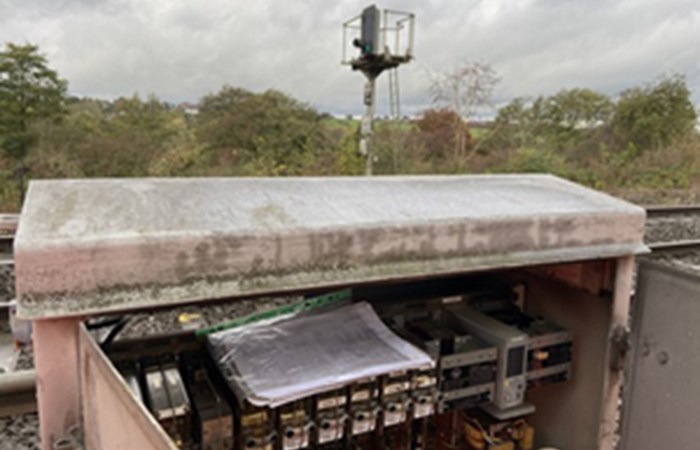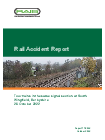Rail Accident Investigation Branch

Summary
At about 07:02 hrs on 26 October 2022, a train travelling between Derby and Chesterfield unexpectedly encountered a signal displaying a red (stop) aspect. The previous signal had displayed a green (proceed) aspect. As the train was travelling at 100 mph (161 km/h), it was unable to stop before the red signal and passed it by about 760 metres. The trains driver called the signaller straight away to report the incident. About 17 minutes later, the following train approached the signal which was now displaying a yellow (caution) aspect. After passing the signal, while travelling at about 20 mph (32 km/h), the driver of the second train saw the taillights of the first train stationary ahead of it and braked to a controlled stop. The second train stopped about 75 metres from the rear of the first train, with both trains now in the same signal section. There were no significant consequences and both trains were able to continue their journeys after obtaining permission from the signaller.
The signal had displayed incorrect aspects to the drivers of the two trains as the wiring controlling its red and yellow aspects was crossed on two terminals in a nearby equipment cabinet, which was where a cable running to the signal was connected to the rest of the signalling system. This cable had been disconnected and reconnected during track engineering work the previous night and this work had introduced the wiring cross, which was not identified when the signal was tested afterwards. The testing was affected by a combination of time pressure, tester workload and possibly by unfamiliarity with the configuration of the signalling equipment. An underlying factor was that Network Rail had taken steps to assure the signal maintenance testing carried out by its own staff but had not yet included testers employed by contractors. A second underlying factor was that no one was carrying out any signalling related assurance activities when this type of track engineering work was taking place.
RAIB noted that the potential for a collision between the two trains was reduced by the actions taken by the signallers at East Midlands Control Centre and the second train driver. RAIB observed four issues with the testing work covering test records, tester licensing, deficiencies with drawings, and the omission of tests the previous night. RAIB also observed that while initial welfare checks were carried out for both drivers, follow-up post-incident welfare checks were only carried out for one of the drivers involved.
Recommendations
As a result of the investigation, RAIB has made five recommendations. The first two are addressed to Bridgeway Consulting and Randstad Solutions and seek to enhance the non-technical skills among the staff working for them, with specific emphasis on effective communication, safe decision?making, and safe behaviours when placed under time pressure. The third is for Network Rail to better manage the workload on lead testers. The fourth is for Network Rail to implement measures to better assure itself that signal maintenance testing by contractors on this type of track engineering work is to the required standard. The fifth, also addressed to Network Rail, is to provide testers with a means of recording the test steps when a signals aspects are tested.
RAIB has also identified six learning points. The first highlights the importance of signal maintenance testers following the required testing process and the second is about staff working in management or supervisory roles not placing testers under undue time pressure to complete their work, even when they are under time pressure themselves due to work overrunning. The third and fourth highlight the importance of communication between signallers and train drivers when an incident occurs. The fifth is a reminder about testing signalling equipment, particularly track circuits, after engineering work has taken place on the track, and the sixth is a reminder to carry out follow-up post-incident checks with all drivers involved in a signalling irregularity.
Andrew Hall, Chief Inspector of Rail Accidents said:
The incident at Wingfield has echoes of the tragic accident at Clapham Junction nearly 35 years ago. Even more worryingly perhaps, it also has echoes of a more recent collision at Waterloo in 2017 and a derailment at Dalwhinnie in 2021. All these events involved a signal that should have been displaying a red aspect to protect against an unsafe situation but was not doing so. In each case, this was due to a fault being introduced in the signalling systems wiring and then not being detected by testing, after work on the system had been undertaken.
The railway implemented very significant changes to processes around the installation, maintenance and testing of signalling systems after the accident at Clapham. The importance of following these established processes to maintain the safety integrity of the signalling system, and the potential for unsafe events to occur when they are not followed, is once again shown by the events at Wingfield.
Some in the railway industry will remember the accident at Clapham; some will not. It is natural that in the aftermath of such a large-scale accident, the importance of following the improved processes that resulted from it would be well and widely understood. The passage of time may tend to diminish that understanding, but three events with similar causes in the last six years shows that it cannot be allowed to do so.
Notes to editors
-
The sole purpose of RAIB investigations is to prevent future accidents and incidents and improve railway safety. RAIB does not establish blame, liability or carry out prosecutions.
-
RAIB operates, as far as possible, in an open and transparent manner. While our investigations are completely independent of the railway industry, we do maintain close liaison with railway companies and if we discover matters that may affect the safety of the railway, we make sure that information about them is circulated to the right people as soon as possible, and certainly long before publication of our final report.
-
For media enquiries, please call 01932 440015.

